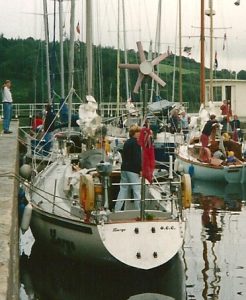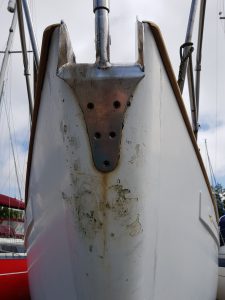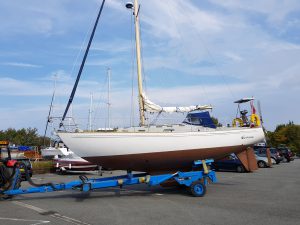This was written a few days ago…
I don’t suppose it would suit everybody but for the first time, I feel I really can say I am Living the Dream. This is what it is like to do exactly as you please…
Samsara is anchored off Stone Point in the Walton Backwaters – that maze of creeks and mud made famous in Swallows and Amazons. In fact it was here, more than sixty years ago that I first went sailing and began to become fanciful about living on a boat.
We are here because I have to paint the decks so I need somewhere quiet not too far away from a water tap (have to wash off the degreasing agent). I arrived a couple of days ago. It’s perfectly sheltered and there is just one other boat here – an old wooden yacht with the bluff bow you see on Dutch classics and a bowsprit almost half as long again. To begin with I thought there was no-one aboard (although there was an ancient dinghy alongside).
Admittedly I had anchored at such a respectful distance that I was looking at her through binoculars – and then today I saw the skipper. A man of about my age – although with more hair. He came out, did something on deck and disappeared without looking my way. But then, why should he. I was watching him through the window.
Today was not a day to go out – bright sunshine but a strong and bitterly cold wind. For the first half hour, I fretted about this. It will probably take me a whole day to clean the decks to standard required by the paint manufacturer… but then, what’s the hurry. My next appointment is for renewing my long-lapsed radio licence on the 29th. I can please myself until then.
And pleasing yourself is one of the most wonderful – and yet one of the rarest- opportunities we have in this life. In fact, looking back, how much of our lives do we spend “pleasing ourselves”. If you live with other people, you have a whole separate agenda to consider – and who wants to be inconsiderate.
But if it’s just you – and nobody knows or cares what you will be doing today – that means you can, for once, please yourself.
I do know that I didn’t get up particularly early – I think it was about eight O’clock. I lingered over breakfast and pulled my one non-navigational book out of the bookcase (it’s all right, the rest are on Kindle but this one has photographs).
I do know that I had several phone conversations with people interested in Network Marketing (more about that on www.networkmarketingblog.org.uk) – a bit of work does have to intrude. There was a text from Tamsin asking whether I would be joining everyone for the annual bucket-and-spade holiday in Southwold but I should be on my way back from the Azores by then. However, it will all have to be paid for (hence the bit of work).
Interestingly, I didn’t resent this at all because it was on my terms. In fact, it was exciting to see that the plan seemed to working – although one conversation lasted for an hour and ten minutes. I’m not sure that’s a good idea – but we talked about all sorts of things and I was in no hurry to say goodbye…
And so, the day slipped past. Lunch was an occasion. I’m getting a real taste for large mugs of sweet tea with condensed milk. Some time in the afternoon, I became so thrilleod with the way things were working out that I decided that tonight will be movie night. This will be a first: I have a dozen favourite DVDs which I will be quite happy to watch again and again (must have seen It’s a Wonderful Life 20 times already). The computer is charged up from carefully monitoring the solar panel and I’ve got a wire to plug in the little waterproof speaker.
It’s not really that cold but the charcoal stove makes the cabin so cosy that I’ll have that as well. In fact, time for dinner, I think…






I like the way you write. It flows nicely and I get to feel the essential feel of the sea. Thankyou.